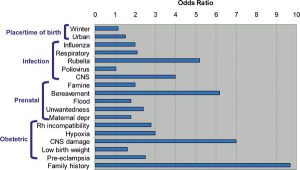
When you hear the world schizophrenia what comes to mind? Crazy? Violent? Perhaps unpredictable? In the world we live in media influences our idea of what metal illness is, and how it affects a person.
In order to understand this metal illness, let’s dive into the science behind schizophrenia.
What’s going on in the brain?
There is a pathway in the brain called the dopamine pathway, which plays a large role in the function of the brain. In a properly working dopamine pathway the enzyme, GSK3 or glycogen synthase kinase 3, plays a key role in the regulation of the dopamine pathway. GSK is activated by the dopamine pathway with the help of the molecule Akt, which phosphorylates GSK to its active form. However, in schizophrenia GSK3 becomes overactive due to too much signaling of the dopamine pathway. This over-activation leads to behaviors associated with this mental illness.
There is another pathway, the Wnt pathway, where GSK is affected in a brain with schizophrenia. Dopamine receptors are also shown to inhibit Wnt signaling. This pathway works to regulate the enzyme GSK, by inactivation through the presence of ß-Catenin. If the balance of ß-Catenin is off, GSK becomes overactive, and much like the previous example leads to the symptoms of schizophrenia.
Risk Factors
There are many different risk factors associated with schizophrenia. Having a family history of illness is the highest risk factor for schizophrenia, however there are also many environmental factors that can cause an increased risk of the disorder. Childhood trauma is another risk factor schizophrenia. Dopamine plays a large part in the interpretation of threat-related stimuli. When a person experiences trauma they have increased levels of dopamine. These increased levels puts an individual at a higher risk.
Maternal infection, along with other prenatal risks increase the odds of developing schizophrenia. During the first trimester if the mother is exposed to influenza, or during the second or third trimester is exposed to rubella or a respiratory infection, that child is at an increased risk for the development of schizophrenia. Birth month is also a risk factor. If a child is born in late winter, or early spring they are at an increased chance of developing the disease. This is thought to be caused by the mother suffering from seasonal depression.

While these are not all of the risk factors, these are some of the biggest, and or most unique risk factors associated with schizophrenia.
Treatments
As with many mental illnesses, current treatments of schizophrenia focus on treating the symptoms of the disease rather than the cause. Due to the fact little is know about the cause of schizophrenia there are no medications that treat the mechanisms behind the disease. Medications that are used to help with symptoms of schizophrenia focus on inhibiting GSK. Lithium is most often used due to the fact it directly inhibits the activation of GSK. In addition, dopamine blockers are also used to help inhibit the dopamine pathway, which in turn inhibits GSK.
What does this have to do with preconceived notions?
It is important to remember that media does not always accurately portray schizophrenia. For many people their only information about this disease comes from movies, and TV shows. This leads to the stigma surrounding schizophrenia, such as a person with this disease is violent, delusional, and experience intense hallucinations. By educating the public about the science behind schizophrenia it can help end the negative stigma surrounding mental illness. It is also important to remember that a person is more than their diagnosis. By proving empathy for those dealing with schizophrenia you can help play a role in ending the stigma surrounding mental illness.
Image 1: https://newroadstreatment.org/signs-of-schizophrenia/
Image 2: http://schizophrenia.com/hypo.php#